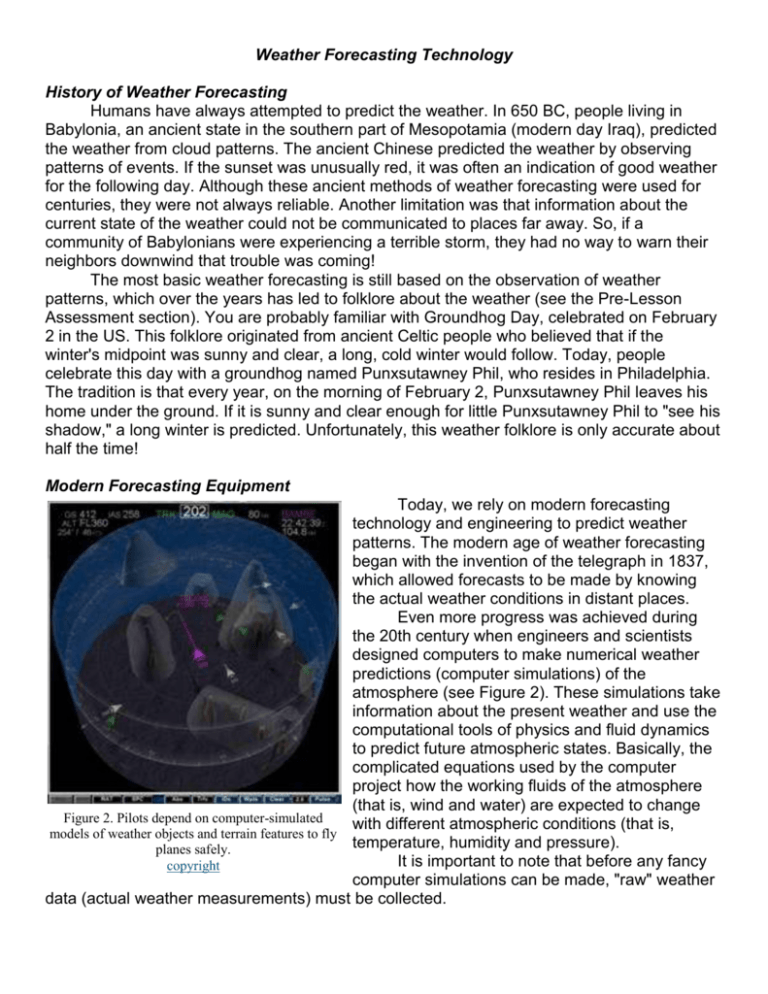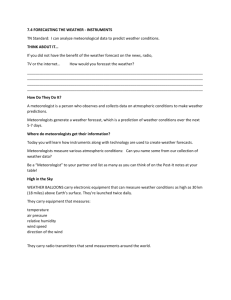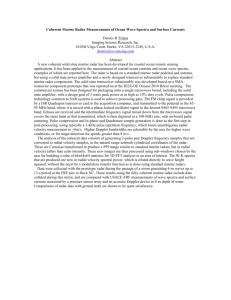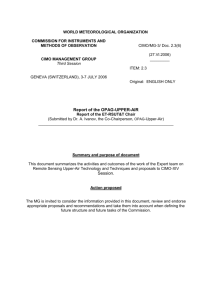Weather Forecasting Technology History of Weather Forecasting
advertisement

Weather Forecasting Technology History of Weather Forecasting Humans have always attempted to predict the weather. In 650 BC, people living in Babylonia, an ancient state in the southern part of Mesopotamia (modern day Iraq), predicted the weather from cloud patterns. The ancient Chinese predicted the weather by observing patterns of events. If the sunset was unusually red, it was often an indication of good weather for the following day. Although these ancient methods of weather forecasting were used for centuries, they were not always reliable. Another limitation was that information about the current state of the weather could not be communicated to places far away. So, if a community of Babylonians were experiencing a terrible storm, they had no way to warn their neighbors downwind that trouble was coming! The most basic weather forecasting is still based on the observation of weather patterns, which over the years has led to folklore about the weather (see the Pre-Lesson Assessment section). You are probably familiar with Groundhog Day, celebrated on February 2 in the US. This folklore originated from ancient Celtic people who believed that if the winter's midpoint was sunny and clear, a long, cold winter would follow. Today, people celebrate this day with a groundhog named Punxsutawney Phil, who resides in Philadelphia. The tradition is that every year, on the morning of February 2, Punxsutawney Phil leaves his home under the ground. If it is sunny and clear enough for little Punxsutawney Phil to "see his shadow," a long winter is predicted. Unfortunately, this weather folklore is only accurate about half the time! Modern Forecasting Equipment Today, we rely on modern forecasting technology and engineering to predict weather patterns. The modern age of weather forecasting began with the invention of the telegraph in 1837, which allowed forecasts to be made by knowing the actual weather conditions in distant places. Even more progress was achieved during the 20th century when engineers and scientists designed computers to make numerical weather predictions (computer simulations) of the atmosphere (see Figure 2). These simulations take information about the present weather and use the computational tools of physics and fluid dynamics to predict future atmospheric states. Basically, the complicated equations used by the computer project how the working fluids of the atmosphere (that is, wind and water) are expected to change Figure 2. Pilots depend on computer-simulated with different atmospheric conditions (that is, models of weather objects and terrain features to fly temperature, humidity and pressure). planes safely. It is important to note that before any fancy copyright computer simulations can be made, "raw" weather data (actual weather measurements) must be collected. Weather Balloons Weathers balloons carry instruments high up into the atmosphere. The balloons, launched every day all over the world, carry a radiosonde high up into the atmosphere. The radiosonde is a small, battery powered device that collects information about atmospheric pressure, humidity, and temperature. These data are then transmitted to a ground antenna via specific radio frequencies. Wind speed and direction are calculated by tracking the weather balloon using GPS or radio direction finding. The flight of a weather balloon doesn't last very long. The weather balloon is filled with either helium or hydrogen, which lifts the device into the atmosphere at a rate of about 1000 feet per minute. In its flight, the weather balloon can ascend to over 35 km (115,000 feet) and drift more than 300 km (about 180 miles) from where it was launched. As the balloon ascends, the pressure decreases, which causes the balloon to expand from an initial diameter of 1.5 feet to 6-8 feet. Eventually the balloon expands so much that it ruptures. The radiosonde has a Figure 3. Weather balloons are launched every day parachute attached to it so that it is less likely to around the world to collect data from the atmosphere. cause damage when it returns to earth. Most copyright radiosondes are not found after they return to earth. Of the approximately 70,000 radiosondes deployed every year, only about 20% are found and returned to the National Weather Service for reconditioning and reuse. Satellite Technology What about the big picture? Weather satellites are another engineering marvel that enable us to see what the Earth and clouds look like from space and give us a more comprehensive view of Earth's interrelated systems and climate. Figure 4 was created using data from four different satellites. The red dots you see are fires burning on land areas, and the large aerosol clouds over the Atlantic Ocean are from the burning of biomass in Africa. You can also see dust and clouds wrapped around the planet. Figure 4. A satellite image of Earth. copyright Weather Radars What if we wanted to see inside a large cloud or storm to analyze its structure and gauge its potential to cause severe weather? Is this possible? Military radar operators asked this same question during World War II, when they noticed noise in returned radar echoes due to weather elements such as rain, snow and sleet. When the war was over, many of these military radar operators became engineers to develop a use for the noisy echoes. Now, we have weather radar, a special type of radar that uses radio waves to "see" how precipitation is behaving in a cloud and how it might change. Figure 5. All weather radars work by the process of scattering. copyright RADAR stands for radio detection and ranging. Basically, a radar is an electronic instrument used to determine the direction and distance of objects that reflect radio energy back to the radar site. Weather radars use radio waves to locate precipitation and determine its type (rain, snow, sleet or hail). They also calculate the motion of precipitation and forecast its future position and intensity. All weather radars work by the process of scattering, in which radiation energy is reflected by small particles, as shown in Figure 5. So, when weather radar sends a radar beam out into space, the precipitation particles in the atmosphere cause the radiation energy to scatter. The motion and behavior of the scattered radiation is read by the radar site and translated into important weather information. The Doppler Radar Most weather radars are Doppler radars, which can also detect the motion of rain droplets. Doppler radar gets its name from the Doppler effect. Have you ever listened to an ambulance siren or a train whistle as it was coming toward you? You probably noticed that the pitch of the whistle changed as the train passed you and moved away. This change in the frequency of sound is called the Doppler effect. A Doppler radar measures the changes in the frequency of the signal it receives to detect the intensity of precipitation, estimate wind direction and speed, and predict hail size and rainfall amounts. Doppler radar gives forecasters Figure 6. Doppler radar used by the U.S. National Weather the capability of providing early detection Service in Sioux Falls, Minnesota. of severe thunderstorms that may bring copyright strong damaging winds, large hail, heavy rain and possibly tornadoes. Figure 7 shows the radar reflectivity image of the Oklahoma City/Twin Lakes Doppler radar taken on May 8, 2003, just before a tornado hit the General Motors plant in the area. Because the Doppler radar (shown is the early formation of the tornado) provided the NOAA National Weather Service with 30 minutes advance warning, officials were able to move the 1,200 employees to a shelter before the tornado hit. Figure 7. Doppler radars give us advance warning of natural hazards, such as tornadoes. copyright Who Uses the Information? We can certainly appreciate the staggering advances in weather forecasting equipment since the telegraph was used 100 years ago. What about the people who use the equipment? Who looks at all this weather data? Who checks to see if it makes sense? One international organization is the World Meteorological Organization (WMO), an agency of the United Nations. WMO works to verify and standardize weather data and make it available to national meteorologists, local forecasters and other people interested in weather science and forecasting. This weather data is then put into maps by computers, which can make forecasts based on certain conditions and mark them on weather maps. Then, it is the meteorologist's job to read and interpret these maps to make forecasts about the weather. You can obtain daily weather information for your city from the World Meteorological Organization by visiting http://worldweather.wmo.int/. It is interesting to note that, according to NASA, the US statistically has the world's most violent weather. In a typical year, the US endures about 10,000 violent thunderstorms, 5,000 floods, 1,000 tornadoes, and several hurricanes. For this reason, improving weather prediction has been a high priority of meteorologists for a very long time. Engineers and scientists continue to work to improve weather forecasting technology to provide more accurate weather forecasts for the benefit of society, the economy and the environment.









